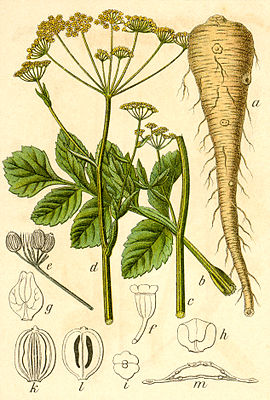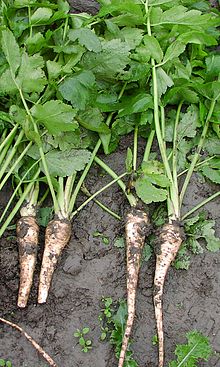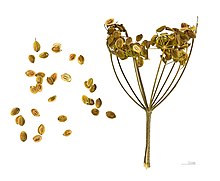parsnip
| parsnip | ||||||||||||
|---|---|---|---|---|---|---|---|---|---|---|---|---|

Parsnip ( Pastinaca sativa ), illustration |
||||||||||||
| Systematics | ||||||||||||
|
||||||||||||
| Scientific name | ||||||||||||
| Pastinaca sativa | ||||||||||||
| L. |
The parsnip ( Pastinaca sativa ), also called the parsnip , is a type of plant from the genus of the parsnip ( Pastinaca ) within the umbelliferae family (Apiaceae). As wild form applies Pastinaca sativa subsp. sativa var. pratensis (meadow parsnip); the cultivated form of vegetable parsnip is called Pastinaca sativa subsp. sativa var. sativa .
The parsnip was chosen by the Association for the Preservation of Crop Diversity as Vegetable of the Year 2011/2012 in Germany.
Description and ecology
Vegetative characteristics
Parsnip grows as a biennial herbaceous plant and reaches heights of 30 to 120 centimeters, rarely up to 300 centimeters. It is a semi-rosette plant with a fleshy turnip, similar in structure to the carrot ( Daucus ). The intense, pleasant smell of all parts of the plant is sweet, somewhat similar to wild fennel ( Foeniculum vulgare ). The stem is angularly grooved. After the first year, a beet develops as a storage organ. The turnip is yellowish-white in color; in the wild form it is thin and hard, in the cultivated varieties it is up to 6 centimeters thick, 20 centimeters long, conical and weighs up to 1.5 kilograms. In contrast to parsley root , parsnip beet has a pronounced edge around the area where the leaves emerge. The underground plant parts are frost hardy .
Their leaves are one to two pinnate with two to seven pairs of leaflets .
Inflorescence, flowers and fruits
Many flowers stand together in seven to 20-rayed double-gold inflorescences . Bracts are not available.
The flowers are hermaphroditic. The calyx teeth are tiny and triangular. The petals are yellow. The flowering period extends from July to September. The flowers are "nectar-bearing disc flowers of the Heracleum type". They are visited by all kinds of insects ( entomophilia ). Wind pollination is possible, but practically does not take place.
The fruits are double achenes that disintegrate into narrow-winged partial fruits. They are wind and animal spreaders. Random spread through ungulates and humans is also possible. The seeds can germinate well for one to two years. The thousand grain weight corresponds to 2.5 to 4 g.
Chromosome number
The chromosome number for all three subspecies is 2n = 22.
Subtaxa and its distribution
- Meadow parsnip ( Pastinaca sativa subsp. Sativa var. Pratensis Pers. ): The rich variety of forms , also native to Central Europe, is also known as mutton carrot , deer carrot , bog root or Italian parsley . It thrives on meadows, on dry slopes and on fields.
- Vegetable parsnip ( Pastinaca sativa subsp. Sativa var. Sativa ): Cultivated in various cultivars for marketing as vegetables.
- Shaggy parsnip ( Pastinaca sativa subsp. Sylvestris (Mill.) Rouy & EGCamus ): Similar to meadow parsnip, but overall very gray-haired. Some authors also use this subspecies as a synonym for Pastinaca sativa subsp. sativa .
- Burning parsnip ( Pastinaca sativa subsp. Urens (Req. Ex Godr.) Celak. , Syn .: Pastinaca umbrosa DC. ): This subspecies is sub-Mediterranean distribution. It occurs in southern Europe, central and eastern Europe, western Asia and the Caucasus.
Occurrence
Parsnip can be found widespread in meadows , especially near paths, on embankments , in gaps in weed fields , in railroad areas, in quarries or in grain and on loamy soils. It thrives best on soils that are rich in alkaline and often lime and nitrogen . According to Ellenberg , it is a light plant and an order character of warmth and drought-bearing, two-year to persistent ruderal meadows ( Onopordetalia acanthii ). It occurs less frequently in the Arrhenatheretum or in plant communities of the Caucalidion association.
In the Allgäu Alps, parsnip rises east of the Höflealpe near Riezlern in the Kleinwalsertal to an altitude of 1350 meters.
Origin and history
Parsnip, which is also coveted by hair game and sheep , has long been part of the human diet. In the Roman Empire it was one of the most popular root vegetables . The Capitulare de villis vel curtis imperii of Charlemagne prescribed the cultivation of parsnips. The juice of the parsnip was used as a medicine during the time of the great plague epidemic in the 14th century , which is why the plant was nicknamed the plague neck . In the food culture of the Middle Ages , starchy parsnip played a role similar to that of the potato in modern times.
Until the middle of the 18th century, parsnip was one of the most important staple foods in Germany and Austria because of its low susceptibility to disease , but was then largely supplanted by potatoes and carrots . In Great Britain , Ireland , the USA , France , the Netherlands , Scandinavia and Hungary, on the other hand, it is still popular as a vegetable and spice plant. The parsnip became better known again in Germany, Austria and Switzerland, especially through organic farming , but it is still rarely available. In the USA it was grown in Virginia in 1609 and in Massachusetts in 1629. In Germany, the culture with experiments was mostly worked on in Veitshöchheim .
Cultivation and harvest
The vegetable parsnip gets along better with a heavier soil than the carrot and tolerates more moisture. Loamy soils are favorable for a high yield, but boggy soils are also advantageous. The pH of the soil should be 5.5 to 7.0. On the latter, the highest yields are achieved with additional irrigation, which can be up to 70 t / ha. Nevertheless, they do not like waterlogging and are therefore best grown on dams. Varieties that are bolt-resistant, conical and smooth, and produce high yields are preferred. Sowing does not take place until March, because otherwise the plants tend to shoot up due to the effects of cold (vernalization) . Sets sown later lead to a decrease in yield due to the shorter cultivation time. The seeds are sown in double rows with a distance of 35 to 70 cm. The distance in the row is 6 to 12 cm. The ideal stand density after deduction of non-germinating seeds is 25 to 30 plants / m². A sowing depth of one, better two centimeters is favorable. Germination takes 15 to 20 days. If the soil is moderately watered and kept moist, the population will germinate more evenly and the earth's surface will not become encrusted so easily in heavier soils. In the main growth from June to the beginning of September, additional irrigation is beneficial. The cultivation time for the slowly growing parsnips is 160 to 210 days. Cultivation work and weed control are almost the same as those of the carrot.
Harvesting takes place from October until the first frost. The roots are stored in order to be ready for use regardless of the weather. The yield is approx. 45 t / ha. The root weights vary from 0.1 to 1.2 kg. The arable waste in the form of leaves is 15 t / ha. It is stored around 0 ° C with a relative humidity of 97% in order to prevent moisture loss.
Diseases and pests
The most common: Carrot blackness Alternaria dahci , downy mildew and powdery mildew , Cercospora leaf spots , carrot fly (Psila rosae) and aphids . For physiological reasons, root scab ( Streptomyces scabies ) can also occur. In the crop rotation, parsnip is best after grain or after green manure , mint or onion family as a preceding crop , but should not follow dill , carrots , parsley and other family species ( umbelliferae ).
use
kitchen
The taste of the roots, which are mainly harvested in winter, is sweet and spicy, sometimes also bitter. This is reminiscent of carrots and celery and is similar to that of parsley root , only milder. They can be baked or cooked and processed into cream soups and purees . Pureed parsnip is sold as baby vegetable puree in jars , especially because of its low nitrate content . Grated, like celery, it can also be prepared as a salad. Parsnips should not be seared too dark, otherwise it will get a bitter taste. Storage for too long can also produce a bitter taste. Among the classics of English cuisine is one parsnip puree , Mashed parsnips which, like mashed potato is cooked, but is much more aromatic. It is traditionally served with roasted or grilled meat. Similar to the potato, parsnip is also used to make chips . Because of its high starch content , parsnip was also used in the past to make beer and parsnip wine. A thick syrup can be made from the juice, which can be used as a spread and sweetener. The leaves of the parsnip can be used as a herb , similar to parsley . For storage, the roots are cut into cubes or strips, blanched and then deep-frozen. They are also used for soup mixes. Parsnip is also used as a shredded and dried product.
ingredients
Compared to carrots, parsnip has four times the content of fiber, potassium, protein and vitamin C. In addition to a high proportion of starch, the whole plant contains bergapten , xanthotoxin and imperatorin . The fruits are rich in essential oil and calcium oxalate . Even on sites that are highly fertilized with nitrogen, the nitrate content is still below 100 mg / kg fresh substance.
| Federal Food Key , version 3.01 | ||||||
| Calorific value | water | potassium | Calcium | phosphorus | vitamin C | |
| 249 kJ (59 kcal ) | 82 g | 523 mg | 47 mg | 82 mg | 18 mg | |
Effect and toxicity
In addition to stimulating the appetite, the pleasure also has a diuretic effect.
When handling parts of plants in connection with sunshine on the skin, phototoxic reactions due to essential oils and meadow grass dermatitis due to the furocoumarins contained therein can occur.
Parsnips in popular culture
In the Donald Duck story The Golden Fleece by Carl Barks appears in the German translation by Erika Fuchs parsnip pudding as an inedible meal. The Donaldists therefore let the run-down conference leader ("PresidentEnte") eat a bowl of parsnip pudding in public at their congresses .
See also
literature
- Lothar Bendel: The great lexicon of fruits and vegetables . Origin, ingredients, preparation, effect. Anaconda Verlag, Cologne 2008, ISBN 3-86647-201-3 , p. 303-305 .
- Günther Liebster: Commodity knowledge vegetables . In: Fruit and vegetables . Completely revised and expanded edition. tape 2 : vegetables . Hädecke, Weil der Stadt 2002, ISBN 3-7750-0309-6 , p. 172-174 .
- Udo Pini : The Gourmet Handbook . 3. Edition. Könemann, Cologne 2000, ISBN 3-8290-1443-0 , p. 736-737 .
- Pan Zehui, Mark F. Watson: Pastinaca . In: Flora of China . tape 14 , 2005, pp. 193 ( efloras.org ).
Web links
- Parsnip. In: FloraWeb.de.
- Parsnip . In: BiolFlor, the database of biological-ecological characteristics of the flora of Germany.
- Pastinaca sativa L. s. l. In: Info Flora , the national data and information center for Swiss flora .
- Distribution in the northern hemisphere according to Eric Hultén
- Thomas Meyer: Ordinary parsnip (Pastinaca sativa) on blumeninschwaben.de.
- Parsnip on biozac.de.
- Root parsley and parsnip . Bavarian State Institute for Agriculture (PDF; 257 kB).
Individual evidence
- ↑ a b c d e Erich Oberdorfer : Plant-sociological excursion flora for Germany and neighboring areas . With the collaboration of Angelika Schwabe and Theo Müller. 8th, heavily revised and expanded edition. Eugen Ulmer, Stuttgart (Hohenheim) 2001, ISBN 3-8001-3131-5 , pp. 694, 721 .
- ↑ a b c d e C. Wonneberger, F. Keller et al .: Gemüsebau , 2004, pp. 137-138, ISBN 3-8001-3985-5 .
- ↑ a b c d e f J. Becker-Dillingen: Handbook of the entire vegetable cultivation. 5th edition, Verlag Paul Parey, 1950, pp. 701-705.
- ↑ a b Ralf Hand: Apiaceae. : ww2.bgbm.org data sheet Pastinaca sativa. In: Euro + Med Plantbase - the information resource for Euro-Mediterranean plant diversity , Berlin 2011 .
- ↑ Erhard Dörr, Wolfgang Lippert : Flora of the Allgäu and its surroundings. Volume 2, IHW, Eching 2004, ISBN 3-930167-61-1 , p. 286.
- ↑ Sabine Kaufmann: Profiles: Root vegetables . In: planet-wissen.de . June 26, 2014. Retrieved December 15, 2015.
- ↑ a b c G. Arold: The parsnip, an old cultivated plant + attempts to grow parsnips. In: vegetables. No. 5, 1987, pp. 252-256.
- ↑ The Parsnip Revival. In: schweizerbauer.ch . December 14, 2019, accessed December 15, 2019 .
- ↑ a b H. C. Thompson: Vegetable Crops. 4th Edition, McGraw-Hill Book Company, New York 1949, pp. 339-341.
- ↑ a b c d R. Theiler, HP Buser, A. Le Fèvre: Parsnips: old and new varieties in comparison. In: Vegetable growing. No. 5, 2003, p. 10 f.
- ↑ a b c I. Jørgensen: Grønsager på Friland. Gartner Info, 1987, p. 192 f.
- ↑ a b c d G. Vogel et al .: Handbook of special vegetable cultivation. Ulmer Verlag, 1996, ISBN 3-8001-5285-1 , pp. 1001-1009.
- ↑ a b c G. Vogel: Parsnip. Vegetable biographies 16, In: Gartenbau-Magazin. No. 11, 1993, p. 47 f.
- ↑ J. Reinhold et al .: Growing fine vegetables outdoors. VEB Deutscher Landwirtschaftsverlag, 1962, pp. 407-410.
- ↑ S. Lerat, A.-M. Simao-Beaunoir, C. Beaulieu: Genetic and physiological determinants of Streptomyces scabies pathogenicity. In: Molecular Plant Pathology. 10, 2009, pp. 579-585. doi: 10.1111 / j.1364-3703.2009.00561.x .
- ^ HR Wehrhahn: Müller's vegetable growing. Gardener's specialist library, Volume 2, H. Killinger Verlagsgesellschaft, approx. 1935, p. 233.
- ↑ The Greatest Stories by Donald Duck - special issue, issue 77; Annotated catalog raisonné , accessed on November 5, 2013.





